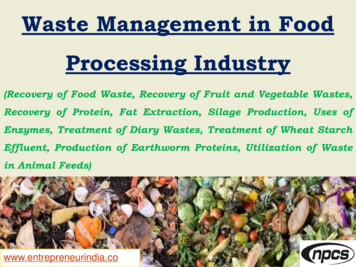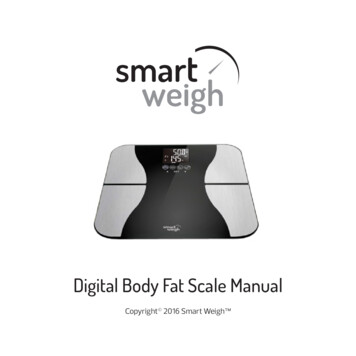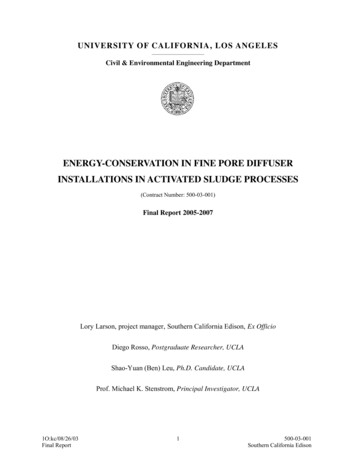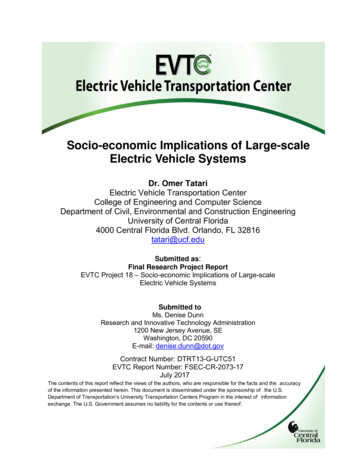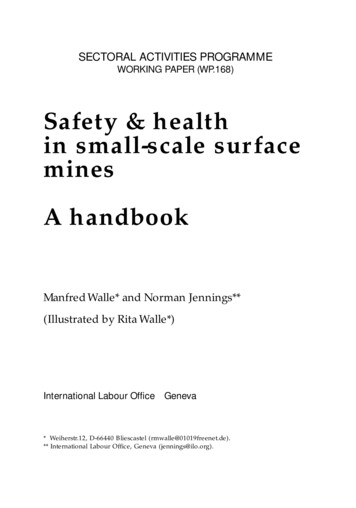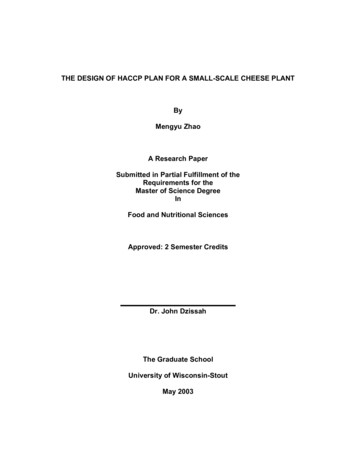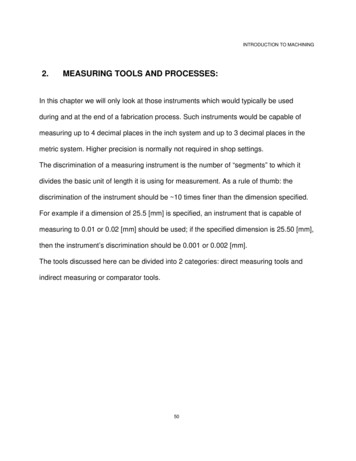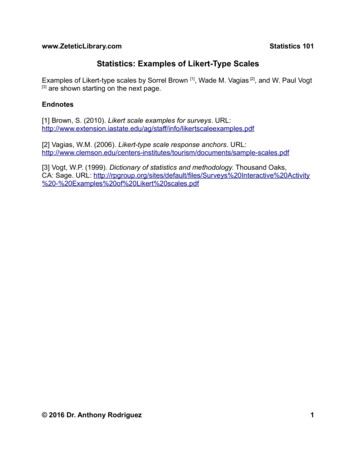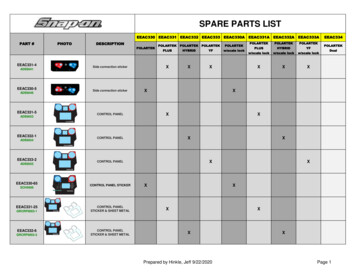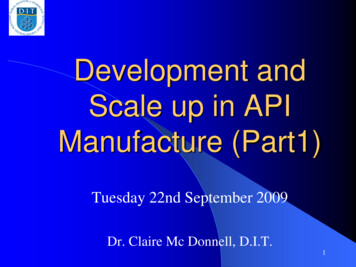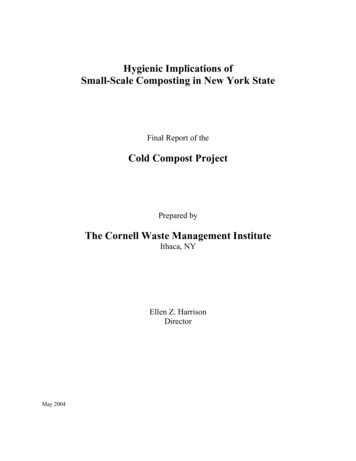
Transcription
Hygienic Implications ofSmall-Scale Composting in New York StateFinal Report of theCold Compost ProjectPrepared byThe Cornell Waste Management InstituteIthaca, NYEllen Z. HarrisonDirectorMay 2004
Cold Compost Project – Final ReportAcknowledgementsThis project was made possible by funding received from the Cornell University AgriculturalExperiment Station and Cornell Cooperative Extension. Useful comments on the fact sheetdeveloped to reflect this project were received from Allison Hornor (Horticulture, CornellUniversity), Uta Krogmann (Rutgers University), Kevin Mathers (Cornell Cooperative Extensionof Broome County) and Adam Michaelides (Cornell Cooperative Extension of TompkinsCounty). Dan Olmstead (CWMI) was the primary author of this report. Joe Regenstein (FoodScience, Cornell University) was a collaborator on the project. Will Brinton (Woods EndResearch Laboratory) provided helpful insights regarding pathogens in compost. While essentialto the quality of this project, these persons do not necessarily endorse the findings andconclusions. CWMI is responsible for the content of the report.AbstractSmall-scale composting is an effective way to recycle organic wastes generated in the homeand/or community. Little research has been done to determine potential human health risk ofcomposts generated on a small scale. Bacteriologic testing of twenty composts from across NewYork State representing a wide variety of small-scale composting practices and situations wasconducted. No statistical relationships were found between concentrations of total coliforms,fecal coliforms, enterococci, Escherichia coli, Salmonella spp., and Clostridium perfringens,indicating that none of these organisms could be considered a good indicator of generalmicrobial presence. Compared with microbial standards for sewage sludge composts, thesecomposts generally met those standards. Basic compost parameters were also analyzed. Waterholding capacity ranged from 50% to 246%, organic matter 9% to 80.5%, C to N ratio 10.4 to29, Total Kjeldahl Nitrogen 0.185% to 2.419%, density 24 lb/ft3 to 82 lb/ft3, solids 27.7% to75.6%, moisture 24.4% to 72.3%, pH 6.54 to 8.65, and Solvita maturity from 3 to 7. Nostatistically significant relationships at the p 0.1 level were found between microbialconcentrations and compost parameters. However, the relationship between pH and TKN wasclose to the statistical cut off, with higher pH and TKN associated with higher concentration ofmicrobes. An unanticipated finding was that the two laboratories used for bacteriological testingemployed different methodologies to look for the same bacteria which may account for some ofthe discrepancy in results between the labs. Researchers and composters alike need to ensureCornell Waste Management Institute2
Cold Compost Project – Final Reportmethods appropriate for compost are used. The results of this research led to a recommendationto follow good hygiene practices (such as washing hands) when working with composts. Similarpractices are advisable when dealing with any soil material since these too may contain bacterialpathogens.KeywordsSmall-scale compost; backyard compost; on-site compost; home compost; community compost;compost pathogens; compost hygieneCornell Waste Management Institute3
Cold Compost Project – Final ReportTable of ContentsAcknowledgements . 2Abstract . 2Keywords. 3Project Objectives. 5Introduction . 5Materials and Methods . 8Project Duration. 8Site Selection . 8Sampling Protocol . 8Microorganisms of Interest. 9Indicator Organisms. 9Pathogenic Organisms . 11Microbial Testing . 12Statistical Analysis . 14Results . 16Physical Parameters. 16Bacterial Concentrations. 17Comparison of Pathogen Concentrations Reported by Laboratory 1 and Laboratory 2 . 17Relation of Compost Physical Parameters to Microbial Concentration. 20Results of Multiple Regression Analysis. 20Correlations between Physical Compost Parameters and Microbial Concentrations . 21Relationship among Microbes . 22Relationship of Compost Practices and Microbial Concentration . 22Discussion. 22Conclusion. 25References . 26Figure 1. Hierarchy of Coliform Bacteria.10Figure 2. Example of a Correlation Graph between C. perfringens and E. coli .16Table 1. Comparison of Laboratory Methods.13Table 2. Ranges of Small Scale Compost Physical Parameters.16Table 3. Ranges of Small-Scale Compost Bacterial Parameters for Laboratory 1 .17Table 4. Ranges of Small-Scale Compost Bacterial Parameters for Laboratory 2 .17Appendix A. Survey Sample and Summary of Results .28Appendix B. Sampling Protocol for Compost Piles .33Appendix C. Physical Data.34Appendix D. Bacterial Data.36Appendix E. Between Lab ANOVA Results of Microbial Concentrations.39Appendix F. Microbe Regression Analysis .42Appendix G. Independent Samples t-tests Microbes vs. Management Practices .61Appendix H. Small Scale Guidance Fact Sheet.70Cornell Waste Management Institute4
Cold Compost Project – Final ReportProject ObjectivesThe overall goals of this study were to: 1) determine the prevalence of selected human pathogensin composts generated in typical small-scale composting systems in New York State; 2) developguidance for composters operating small-scale systems for, minimizing pathogen risks; and 3)train and educate Extension educators and others about minimizing exposure to pathogens fromsmall-scale composting systems.IntroductionA majority of solid waste generated in the United States is organic material that can be recycledthrough composting (USEPA 1999). On-site composting of yard trimmings and food scraps athomes, businesses, and institutions is the most environmentally sound approach to organic wasterecycling since it avoids transportation impacts and the impacts of large centralized facilities. Italso makes the resulting compost available for use by the generator. To be successfully used,however, the quality of the compost must be appropriate for its intended purpose. For use ingardens, hygienic quality in regard to pathogenic organisms is an important quality criteria.This work focuses on the hygienic quality of composts produced in small-scale compost systemsat homes, schools and multi-family residences. While disease causing organisms represent onlya very small fraction of the microbial community in compost piles, but there are factors that needto be considered. A literature search revealed very few data on this subject.Research has shown that compost achieving the “temperature/time” regime required for properoperation of large, permitted composting facilities is effective in pathogen destruction (althoughsubsequent recontamination of the compost and regrowth of microorganisms can be a problem)(Bollen 1990; ODEQ 2001). Although it is commonly believed that reaching temperatures of55 C for 3 days is sufficient to essentially eliminate bacterial pathogens (Yanko et al. 1995),recent work suggests that the control of bacterial pathogens in composting is more complex andnot simply the result of thermal treatment (Droffner and Brinton 1995). Salmonella, E. coli, andother bacteria survived high temperatures for a significant time (Droffner and Brinton, 1995), butwhether the high temperature resistant strains are pathogenic is unknown (Droffner and Brinton1994). Moisture level, for example, is also important in the survival of E. coli through theCornell Waste Management Institute5
Cold Compost Project – Final Reportcomposting process (Droffner and Brinton, 1995). It has been suggested that microbialcompetition is also important in the destruction of pathogenic organisms in compost. If so, iffinished composts with low levels of competing microorganisms become inoculated withpathogens, there would be an increased potential for high pathogen levels due to regrowth in theabsence of competition. .A review of abstracts on manure composting and pathogens suggest the following: Most of the research work is done on fairly controlled compost piles, in contrast with whatmay actually take place on farms or at homes or schools (Skjelahugen 1992; Cooperband andMiddleton 1996; Graft-Hanson et al. 1990). The data, even in these cases, is inconsistent. Some piles seem to rapidly lose organisms(Schleiff and Dorn 1997; Graft-Hanson et al. 1990; Forshell and Ekesbo 1993), while otherstake much longer (Slawon et al. 1998). In other cases, minimal change was observed(Kikuchi and Ataku 1998; Tiquia et al. 1998) or in one case the number of organismsactually increased with time (Mote et al. 1988). The actual organisms studied varied, but E. coli and Salmonella are a recurring theme,because they are two organisms associated with animal manures, and presumably also offood wastes, that are of concern to human health (Skjelahugen 1992; Cooperband andMiddleton 1996; Schleiff and Dorn 1997). These organisms are used by US EnvironmentalProtection Agency and many states as “indicator” organisims for products derived fromsewage sludges. The term “indicator organism” is discussed in the Materials and Methodssection. The attempt to relate critical processing and compost pile factors to the outcome ofcomposting with respect to pathogen concentrations has received minimal attention. Commonly used methods for the detection of Salmonella and Listeria may fail to detect thosepresent (Yanko et al, 1995; Droffner and Brinton 1995).A literature review and discussions with experts turned up almost no information on the topic ofsafety in regard to pathogens for small-scale composting systems. One article, published byGerman authors, did find that small compost systems do not generate adequate heat to kill humanpathogens such as Salmonella (Roth 1994).Cornell Waste Management Institute6
Cold Compost Project – Final ReportInformation about the time/temperature behavior of pathogens in the temperature range ofinterest is also limited. Data used for food service establishments where food temperatures aredirected to be above 60 C or below 4.4 C are not directly relevant to these compost systems.In large-scale composting operations, pathogen concerns may arise if either; 1) adequatetemperatures are not achieved for sufficient duration to ensure pathogen destruction, or 2)recontamination occurs after the composting process is successfully achieved. The OregonDepartment of Environmental Quality (2001) states that regrowth of bacterial pathogens mayoccur when there is available carbon, adequate moisture, and a lack of competitive organisms. Insmall composting systems, these conditions are frequently the norm.Most home and small institutional and commercial compost systems do not reach 55 C, or ifthey do, composts may not maintain temperatures for sufficient lengths of time for pathogenreduction. The temperature as recorded (when this is done) is often hottest toward the core of thepile and cooler along the pile’s edges. Given the less systematic nature of turning in most of thesmaller compost systems, it is likely that even with piles that self-heat, not all of the compostwill be subjected to the higher temperatures. Thus, if pathogens are present, they may persistthrough the composting process.Another concern raised by Droffner and Brinton (1995) and Yanko et al. (1995), is whether thestandard techniques used for microbiological characterization of pathogens are effective withcompost samples. As Droffner and Brinton’s experiments with Listeria demonstrate, theenrichment media does not enrich for those organisms that survived the high temperature regimein the compost. Comparing five methods for enumeration of Salmonella in composts andsludges, Yanko, et al. (1995), found that the EPA approved methods significantly under counted.Thus, standard methods may not accurately measure pathogens in the compost.Cornell Waste Management Institute7
Cold Compost Project – Final ReportMaterials and MethodsProject DurationThis project took place over a 3-year period and included two separate sampling events. Thefirst began in April of 2001 and was completed in January of 2002. This period of time isreferred to as the “early” sampling period. The second sampling event began in September of2002 and was completed by the end of October of the same year. The second sampling period isreferred to as the “late” sampling period.Site SelectionTwenty sites across New York State were selected to participate in this study. Of these, 6participated only in the early round of sampling, while the remaining 14 participated in the fullstudy with samples analyzed both in 2001 and 2002. Data regarding compost management wasalso obtained for each site through a questionnaire. (See Appendix A for a copy of thequestionnaire and a summary of the results). Sites were identified by Cornell CooperativeExtension educators in New York City, Tompkins County, and Schuyler County, New York whowork with home, school and multi-family residential composters.Sites for which data were collected include 10 homes, 6 communal compost piles (at communitygardens, multi-family residences, or the workplace), 2 schools and one dormitory residence.Sampling ProtocolEach sample consisted of 16 representative grab samples gathered from the compost pile, usingstandard collection techniques to prevent contamination and obtain a representative sample (SeeAppendix B). Each composite grab sample was placed in a 5-gallon bucket lined with a cleangarbage bag. Using clean vinyl gloves, the contents were mixed thoroughly to provide asuniform a composite sample as possible. Two testing laboratories were used. For eachlaboratory, 2 heavy-duty 1-quart Zip-locTM bags were filled using a portion of the compositesample, and clearly labeled.The sealed bags were packed in insulated styrofoam containers with ice to minimize bothmicrobial growth and death. Samples going to laboratory #1 for analysis were dropped off inCornell Waste Management Institute8
Cold Compost Project – Final Reportperson after sampling was finished for the day. Samples going to laboratory #2 were shippedovernight.Microorganisms of InterestIndicator Organisms It is impractical to detect and enumerate all pathogenic organisms ofconcern. In assessing hygienic quality, typically certain microbes are selected to serve as“indicator organisms.” The assumption is made that if the indicator organism is absent orpresent in sufficiently low levels, that other pathogenic organisms will also be reduced toacceptable levels. To be a good indicator of compost hygienic quality, the microbe must bepresent in the initial stages, it must be suitable for analysis using the appropriate methods, and itshould be among the hardiest of the pathogens (Prescott et al. 1996).In this project, several coliform bacteria and fecal Streptococcus were chosen as indicatororganisms. Coliforms are part of the Enterobacteriaceae family, which includes Escherichiacoli, Enterbacter aerogens, and Klebsiella pneumoniae. Coliforms represent about 10% of theintestinal microorganisms in the human gut. Defined as “facultative anaerobic, gram-negative,non-spore forming, rod-shaped bacteria that ferment lactose within 48 hours at 35 C,” coliformsare widely used as indicator organisms because they are more resistant to desiccation than othermicrobes found in human and animal digestive systems (Prescott et al. 1996). No indicator isperfect and one study showed that E. coli survived longer in outdoor soil than Streptococcusfaecalis during summer, while in spring and winter the fecal strep survived much longer (Donselet al 1967). This makes the use of E. coli as an indicator questionable.Fecal coliform are a sub-group of total coliforms (see Figure 1). Total coliform counts ofteninclude organisms that do not reside in the intestinal tract, so methods have been developed totest for fecal coliforms, which by definition are supposed to be coliform microbes that growwhen a temperature of 45 C (i.e., the temperature of the human gut) is maintained duringincubation. The E. coli and Enterococci, tested in this study, are fecal coliforms.Cornell Waste Management Institute9
Cold Compost Project – Final ReportTOTAL COLIFORMSFECAL COLIFORMSE COLIENTEROCOCCIFigure 1. Hierarchy of coliform bacteriaEscherichia coli – E. coli are a natural inhabitant of the human digestive tract, and are found inthe large intestine. E. coli are facultatively anaerobic bacteria, which means they do not needoxygen for growth, but do better in its presence. E. coli is the most abundant microbe in thefecal coliform group but represents only 0.1% of the total microbe population in the human gut(Prescott et al. 1996).Often, undercooked ground beef or unprocessed milk is responsible for disease due to coliforms(Prescott et al. 1996). Potential sources of E. coli in a home composting environment includemeat scraps as well as natural sources. An examination of soils found evidence of total coliform,fecal coliforms, total strep and fecal strep in pasture and forest soils (Faust, 1982). The fecalcoliforms in the forest soils were identified primarily as E. coli.Enterococci spp. - These organisms are found in the small intestine of most mammals, includinghumans. E. faecalis is the most common member of the Enterococci group, and can causeurinary tract infections, as well as endocarditis, an infection of the heart lining, in rare cases(WebMD 2003b). Enterococci are commonly found in the gastrointestinal tract of humans andanimals, and may enter the small-scale compost pile through natural sources such as animal scat.Enterococci and fecal Streptococci are closely related, and form a subgroup of fecal coliforms(Prescott et al. 1996).Fecal Streptococcus - Streptococci and Enterococci are closely related and part of a sizable,complicated genus of bacteria. Streptococci are non-motile and do not form endospores (i.e.,Cornell Waste Management Institute10
Cold Compost Project – Final Reportthick-walled spores that can resist heat and chemicals). Members of this group are responsiblefor streptococcal sore throats and rheumatic fever, but some species comprise part of the naturalflora of human mouth and respiratory tract. Small-scale composts may become inoculatedthrough post consumer food waste. For this study, fecal Streptococci were used as an indicatororganism (Prescott et al. 1996).Pathogenic OrganismsSalmonella spp.-Some types of Salmonella bacteria can cause food poisoning. Salmonella areincluded because they may be found in a variety of foods that are added to home composts suchas dairy and meat products, poultry, eggs, and fish. Salmonella survive independently of ahuman host, and can be transported in the intestinal tract of animals that include dogs and cats,livestock including cattle, horses, swine, sheep, and fowl, and wildlife including rodents, birds,turtles, and reptiles (Prescott et al. 1996). Home composts can be exposed to any of these, eitherdirectly or indirectly.Infections with Salmonella can cause food poisoning, and is termed Salmonellosis. Symptomsmay include diarrhea and mild fever. Less frequently muscle aches, headaches and nausea mightoccur. These symptoms appear because Salmonella microbes secrete enterotoxins (i.e., toxinsthat affect cells in the intestinal lining) and cytotoxins (i.e., toxins or antibodies that impact onlycertain specific cell types). The two most common species causing Salmonellosis are S.typhimurium and S. enteritidis (Prescott et al. 1996).Clostridium perfringens – C. perfringens is commonly found growing in reheated meat dishes,and if large quantities of this microbe are ingested, severe diarrhea can quickly occur, as well asoccasional vomiting. Recovery takes place in a healthy person within 4 days, but the symptomsof C. perfringens infection can be serious. C. perfringens is naturally present in the soil and maybecome incorporated into composts through soil mixing. C. perfringens is also associated withfood poising in cases were meat is rewarmed. Small-scale compost piles may be inoculatedthrough natural sources or meat scraps in post consumer food waste (Prescott et al. 1996).Cornell Waste Management Institute11
Cold Compost Project – Final ReportMicrobial TestingThe two laboratories used different methodologies for measuring bacteria. Laboratory #1specializes in testing water samples for microorganisms, but has limited experience working withcompost and solid mediums. Laboratory #2 specializes in compost testing, and has many yearsof experience working with and testing solid media. See Table 1 for a comparison of testmethods.Cornell Waste Management Institute12
Cold Compost Project – Final ReportMethodologyLab 1 (Early and late samples)E. coliClostridium perfringens: Membrane FilterMethod, ICR Microbial Laboratory Manual.USEPA Office of Research andDevelopment, Washington DC. EPA/600/R95/178 (1996)IDEXX Colilert SystemTotal ColiformIDEXX Colilert SystemEnterococciIDEXX Enterolert SystemC. perfringensFecal Coliforms Fecal Coliforms in Biosolids by MultipleTube Fermentations and MembraneFiltration Procedures: EPA Method 1680(EPA-821-R-98-003)Lab 2 (Late samples only)Compendium of Methods for theMicrobiological Examination ofFoods, 3rd EditionPart 9221 F., “Standard Methods forthe Examination of Water andWastewater”, 18th Edition, 1992,American Public Health Association,1015 15th St, NW, Washington, DC20005Part 9221 B., “Standard Methods forthe Examination of Water andWastewater”, 18th Edition, 1992,American Public Health Association,1015 15th St, NW, Washington, DC20005Part 9230 B., “Standard Methods forthe Examination of Water andWastewater”, 18th Edition, 1992,American Public Health Association,1015 15th St, NW, Washington, DC20005Part 9221 E., “Standard Methods forthe Examination of Water andWastewater”, 18th Edition, 1992,American Public Health Association,1015 15th St, NW, Washington, DC20005Not ApplicableDetection and Enumeration of Salmonellasp. (Kenner and Clark, 1974) as publishedby EPA (1992) Environmental Regulationsand Technology. Control of Pathogens andVector Attraction in Sewage Sludge. pp 107115.Salmonella*Method 1682: Salmonella spp. in Biosolids Part 9260 D., “Standard Methods for(late samples)by Enrichment, Selection, and Biochemical the Examination of Water andWastewater”, 18th Edition, 1992,Characterization. EPA-821-R-98-004American Public Health Association,1015 15th Street, NW., Washington,DC 20005*Method of Salmonella Detection in second round of sampling.Table 1. Comparison of Laboratory MethodsSalmonella(early samples)Cornell Waste Management Institute13
Cold Compost Project – Final ReportAs a hedge against this uncertainty, in addition to using the EPA’s “most probable number”(MPN) technique (EPA 40 CFR Part 503), we also examined compost samples by a differentcultural method specific for E. coli 0157:H7 by plating on sorbitol-MacConkey-MUG agar. Lowlevels of fecal coliform ( 1000 MPN per gram dry solids) and very low Salmonella ( 3 MPNper 4 g solids) with a negative for E.coli 0157:H7 (at a detection limit of 1 cell/25 g solids) willbe interpreted as a sign of a very hygienic compost.Compost samples collected during early sampling were mostly analyzed by Lab 1. Lab 2 didsome limited testing of non-microbial parameters on samples submitted toward the end of theearly sampling. In the second round of sampling, lab 1 measured non-microbial parameters aswell as C. perfringens, E. coli, Enterococci, Salmonella, total coliforms, fecal coliforms, andfecal Streptococci. Lab 2 tested for C. perfringens, E. coli, Enterococci, Salmonella, totalcoliforms, and fecal coliforms. Laboratory 1 changed reporting units for all of the microbesexcept clostridium and fecal coliform midway through the project. For example, samplescollected in early 2001 reported E. coli in MPN (most probable number)/100mL but thenswitched in 2002 to MPN/g.Statistical AnalysisWe used statistical methods to address several questions.1. Was there a significant difference between the results from laboratory 1 and laboratory 2?2. Could values for various compost parameters (such as pH) be correlated with microbialconcentrations?3. Was there a correlation between presence and concentration of the various microbes?Statistical methods included ANOVA, which was used to address question 1. The variancebetween sample means from laboratory 1 and laboratory 2 was analyzed and then compared tothe variance within each laboratory data set.Multiple regression analysis was used to address question 2. We examined the influence of anumber of independent variables on the concentration of each particular microbe (the dependentvariable). An example is provided below:Cornell Waste Management Institute14
Cold Compost Project – Final ReportY a b1*X1 b2*X2 bP*XPWhereY dependent variablea constantb1 slope of independent variable 1b2 slope of independent variable 2bp slope of independent variable PX1 value of independent variable 1X2 value of independent variable 2Xp value of independent variable PThe independent variables used for regression analysis in this study are organic matter (OM),C:N ratio (CN), density, Total Kjeldahl Nitrogen (TKN), moisture, pH, and conductivity (salts).The dependent variable is one of the following: Clostridium, E. coli, enterococci, fecal coliforms,fecal strep, and total coliform. Multiple regression analyses were performed to determinewhether microbial concentrations could be predicted from the other variables. A test ofsignificance was used so that results are reported only when the prediction equation was 90%more likely than “guessing” to determine the average value of whatever microbe being evaluatedare reported.Question 3 was addressed by constructing scatterplot graphs comparing one microbe to another.For example, data for E. coli would be placed on the X-axis of a scatterplot gra
in composts generated in typical small-scale composting systems in New York State; 2) develop guidance for composters operating small-scale systems for, minimizing pathogen risks; and 3) train and educate Extension educators and others about minimizing exposure to pathogens from small-scale composting systems. Introduction
